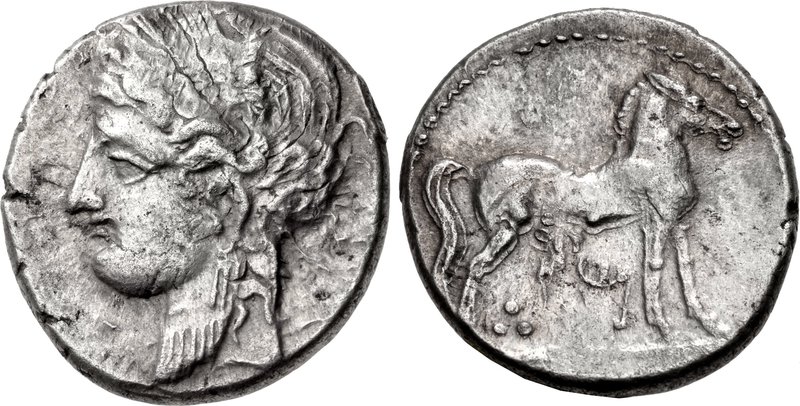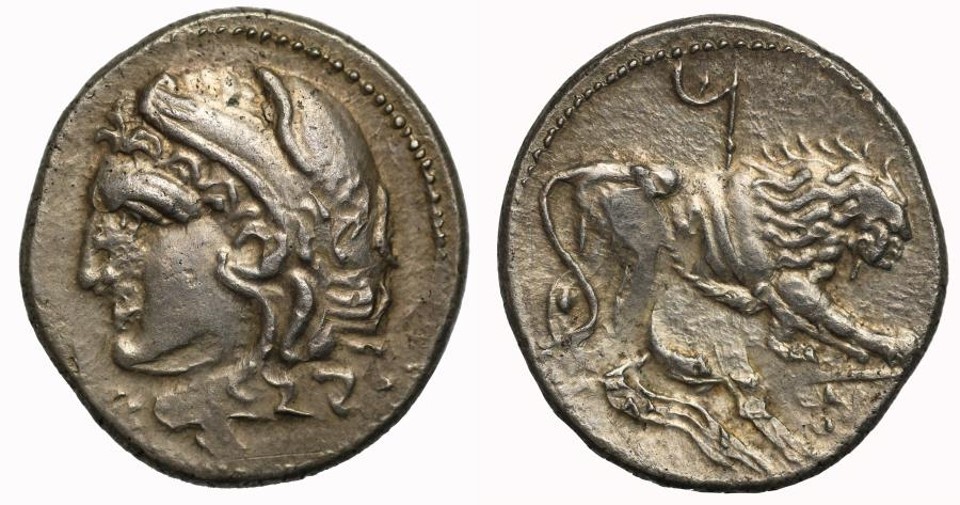SO 229 - Carthage over uncertain mint: Difference between revisions
From SILVER
No edit summary |
No edit summary |
||
| Line 6: | Line 6: | ||
|Obverse description=Head of Herakles left, wearing lion skin headdress. Border of dots. | |Obverse description=Head of Herakles left, wearing lion skin headdress. Border of dots. | ||
|Reverse legend=ΛΙΒΥΩΝ | |Reverse legend=ΛΙΒΥΩΝ | ||
|Reverse legend language=Greek | |||
|Reverse description=Lion prowling right. Above, 'M' (Punic letter). Border of dots. | |Reverse description=Lion prowling right. Above, 'M' (Punic letter). Border of dots. | ||
|Mint= | |Mint=Zeugitana (uncertain mint) | ||
|Ancient region=Zeugitana | |Ancient region=Zeugitana | ||
|Authority=Carthaginian Empire; Lybian mercenaries (241-237 BCE) | |Authority=Carthaginian Empire; Lybian mercenaries (241-237 BCE) | ||
Latest revision as of 13:32, 15 May 2024
241 BCE - 237 BCE | ΛΙΒΥΩΝ
Images
Overstruck variety

Ref tanit horse.jpg [1]
Location/history
| Sale(s)Sale(s) ᵖ: | Sovereign Rarities | |
Overstriking coin
Description
| ObverseInscription or printing placed on the obverse.: | Head of Herakles left, wearing lion skin headdress. Border of dots. | ReverseInscription or printing placed on the reverse.: | ΛΙΒΥΩΝ (Greek) Lion prowling right. Above, 'M' (Punic letter). Border of dots. |
Mint and issuing power
| MintIdentifies the place of manufacture or issue of a numismatic object.: | Zeugitana (uncertain mint) | Ancient regionAncient region. | Zeugitana | Modern countryModern country: Tunisia | AuthorityIdentifies the issuing power. The authority can be "pretended" when the name or the portrait of X is on the coin but he/she was not the issuing power. It can also be "uncertain" when there is no mention of X on the coin but he/she was the issuing power according to the historical sources: | Carthaginian Empire, Lybian mercenaries (241-237 BCE) |
Chronology
| FromIdentifies the initial date in a range assigned in a numismatic context. 241 BCE toIdentifies the final date in a range assigned in a numismatic context.. 237 BCE | Hellenistic 323-30 BC |
Physical description
| MetalThe physical material (usually metal) from which an object is made.: Silver |
WeightWeight of the numismatic object (in grams). in grams: 7.177.17 g <br />7,170 mg <br /> | DenominationTerm indicating the value of a numismatic object. Examples: tetradrachm, chalkous, denarius.: shekel |
AxisDescribes the directional relationship between the obverse and reverse of a numismatic object.: 1212 mm <br />1.2 cm <br /> |
References
| Coin referenceReference of the Coin: | Coin series referenceReference to coin series study: | Carradice - La Niece 19881Carradice - La Niece 1988, n°1, SNG Copenhagen North Africa2SNG Copenhagen North Africa, n°239, Alexandropoulos 20073Alexandropoulos 2007, n°53 | |
| Coin series web referenceCoin series web references: | |||
Overstruck type
Description
| ObverseInscription or printing placed on the obverse.: | Head of Tanit left, wearing wreath of grain ears, necklace and earring | ReverseInscription or printing placed on the reverse.: | Horse right. Below, Punic letter mem |
Mint and issuing power
| MintIdentifies the place of manufacture or issue of a numismatic object. ᵖ: | Zeugitana (uncertain mint) | Ancient regionAncient region. ᵖ | Zeugitana | Modern countryModern country: Tunisia | AuthorityIdentifies the authority in whose name (explicitly or implicitly) a numismatic object was issued. ᵖ: | Carthaginian Empire |
Chronology
| FromIdentifies the initial date in a range assigned in a numismatic context. 241 BCE toIdentifies the final date in a range assigned in a numismatic context.. 238 BCE | Hellenistic 323-30 BC |
Physical description
| DenominationTerm indicating the value of a numismatic object. Examples: tetradrachm, chalkous, denarius. ᵖ: | shekel |
References
| Coin type referenceReference to coin series study ᵖ: | Carradice - La Niece 19881Carradice - La Niece 1988, pl.9, n°40, SNG Copenhagen North Africa2SNG Copenhagen North Africa, n°236, Alexandropoulos 20073Alexandropoulos 2007, n°50 |
Additional data
| Frequency of overstrikesFrequency of overstrikes: | frequent | Level of confidenceLevel of confidence of the identification: | strong |
| RemarksRemarks: | "the visible undertype on the reverse, apparently that of a shekel of Carthage" | ||
